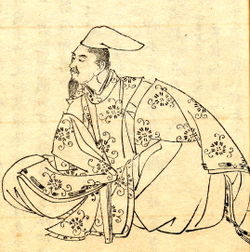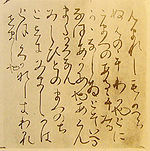
Ki no Tsurayuki
Encyclopedia

Poet
A poet is a person who writes poetry. A poet's work can be literal, meaning that his work is derived from a specific event, or metaphorical, meaning that his work can take on many meanings and forms. Poets have existed since antiquity, in nearly all languages, and have produced works that vary...
and courtier of the Heian period
Heian period
The is the last division of classical Japanese history, running from 794 to 1185. The period is named after the capital city of Heian-kyō, or modern Kyōto. It is the period in Japanese history when Buddhism, Taoism and other Chinese influences were at their height...
.
Tsurayuki was a son of Ki no Mochiyuki. He became a waka
Waka (poetry)
Waka or Yamato uta is a genre of classical Japanese verse and one of the major genres of Japanese literature...
poet in the 890s. In 905, under the order of Emperor Daigo
Emperor Daigo
was the 60th emperor of Japan, according to the traditional order of succession.Daigo's reign spanned the years from 897 through 930. He is named after his place of burial.-Traditional narrative:...
, he was one of four poets selected to compile the Kokin Wakashū, an anthology of poetry.
After holding a few offices in Kyoto
Kyoto
is a city in the central part of the island of Honshū, Japan. It has a population close to 1.5 million. Formerly the imperial capital of Japan, it is now the capital of Kyoto Prefecture, as well as a major part of the Osaka-Kobe-Kyoto metropolitan area.-History:...
, he was appointed the provincial governor of Tosa province
Tosa Province
is the name of a former province of Japan in the area that is today Kōchi Prefecture on Shikoku. Tosa was bordered by Iyo and Awa Provinces. It was sometimes called .-History:The ancient capital was near modern Nankoku...
and stayed there from 930 until 935. Later he was presumably appointed the provincial governor of Suo province
Suo Province
was a province of Japan in the area that is today the eastern part of Yamaguchi Prefecture. It was sometimes called . Suō bordered on Aki, Iwami, and Nagato Provinces....
, since it was recorded that he held a waka party (Utaai) at his home in Suo.
He is well-known for his waka
Waka (poetry)
Waka or Yamato uta is a genre of classical Japanese verse and one of the major genres of Japanese literature...
and is counted as one of the Thirty-six Poetry Immortals
Thirty-six Poetry Immortals
The Thirty-six Poetry Immortals are a group of Japanese poets of the Nara, Asuka and Heian periods selected by Fujiwara no Kintō as exemplars of Japanese poetic ability. There are five female poets among them...
selected by Fujiwara no Kintō
Fujiwara no Kinto
, also known as Shijō-dainagon, was a Japanese poet, admired by his contemporaries and a court bureaucrat of the Heian period. His father was the regent Fujiwara no Yoritada and his son Fujiwara no Sadayori...
. He was also known as one of the editors of the Kokin Wakashū. Tsurayuki wrote one of two prefaces to Kokin Wakashū; the other is in Chinese. His preface was the first critical essay on waka
Waka (poetry)
Waka or Yamato uta is a genre of classical Japanese verse and one of the major genres of Japanese literature...
. He wrote of its history from its mythological origin to his contemporary waka, which he grouped into genres, referred to some major poets and gave a bit of harsh criticism to his predecessors like Ariwara no Narihira
Ariwara no Narihira
was a Japanese waka poet and aristocrat. He was one of six waka poets referred in the preface in kana to Kokin Wakashū by Ki no Tsurayuki, and has been named as the hero of The Tales of Ise, whose hero was an anonym in itself but most of whose love affairs could be attributed to Narihira.He was the...
.
His waka is included in one of the important Japanese poetry anthologies, the Hyakunin Isshu
Hyakunin Isshu
is a traditional anthology style of compiling Japanese waka poetry where each contributor writes one poem for the anthology. Literally, it translates to "one hundred people, one poem [each]"...
, which was compiled in the 13th century by Fujiwara no Teika
Fujiwara no Teika
Fujiwara no Teika , also known as Fujiwara no Sadaie or Sada-ie, was a Japanese poet, critic, calligrapher, novelist, anthologist, scribe, and scholar of the late Heian and early Kamakura periods...
, long after Tsurayuki's death.
Works

Kana
Kana are the syllabic Japanese scripts, as opposed to the logographic Chinese characters known in Japan as kanji and the Roman alphabet known as rōmaji...
. The text details a trip in 935 returning to Kyoto
Kyoto
is a city in the central part of the island of Honshū, Japan. It has a population close to 1.5 million. Formerly the imperial capital of Japan, it is now the capital of Kyoto Prefecture, as well as a major part of the Osaka-Kobe-Kyoto metropolitan area.-History:...
from Tosa province
Tosa Province
is the name of a former province of Japan in the area that is today Kōchi Prefecture on Shikoku. Tosa was bordered by Iyo and Awa Provinces. It was sometimes called .-History:The ancient capital was near modern Nankoku...
, where Tsurayuki had been the provincial governor.
Tale of Genji
Tsurayuki's name is referred to in the Tale of Genji as a waka master. In this story, Emperor UdaEmperor Uda
was the 59th emperor of Japan, according to the traditional order of succession.Uda's reign spanned the years from 887 through 897.-Name and legacy:Before his ascension to the Chrysanthemum Throne, his personal name was or Chōjiin-tei....
ordered him and a number of female poets to write waka on his panels as accessories.
External links
- e-texts of Tsurayuki's works at Aozora bunkoAozora BunkoAozora Bunko is a Japanese digital library. This online collection encompasses several thousands of works of Japanese-language fiction and non-fiction. These include out-of-copyright books or works that the authors wish to make freely available....
- A Note on the English Translation: an example of his poem from the Hyakunin IsshuHyakunin Isshuis a traditional anthology style of compiling Japanese waka poetry where each contributor writes one poem for the anthology. Literally, it translates to "one hundred people, one poem [each]"...
with seven different translations,

